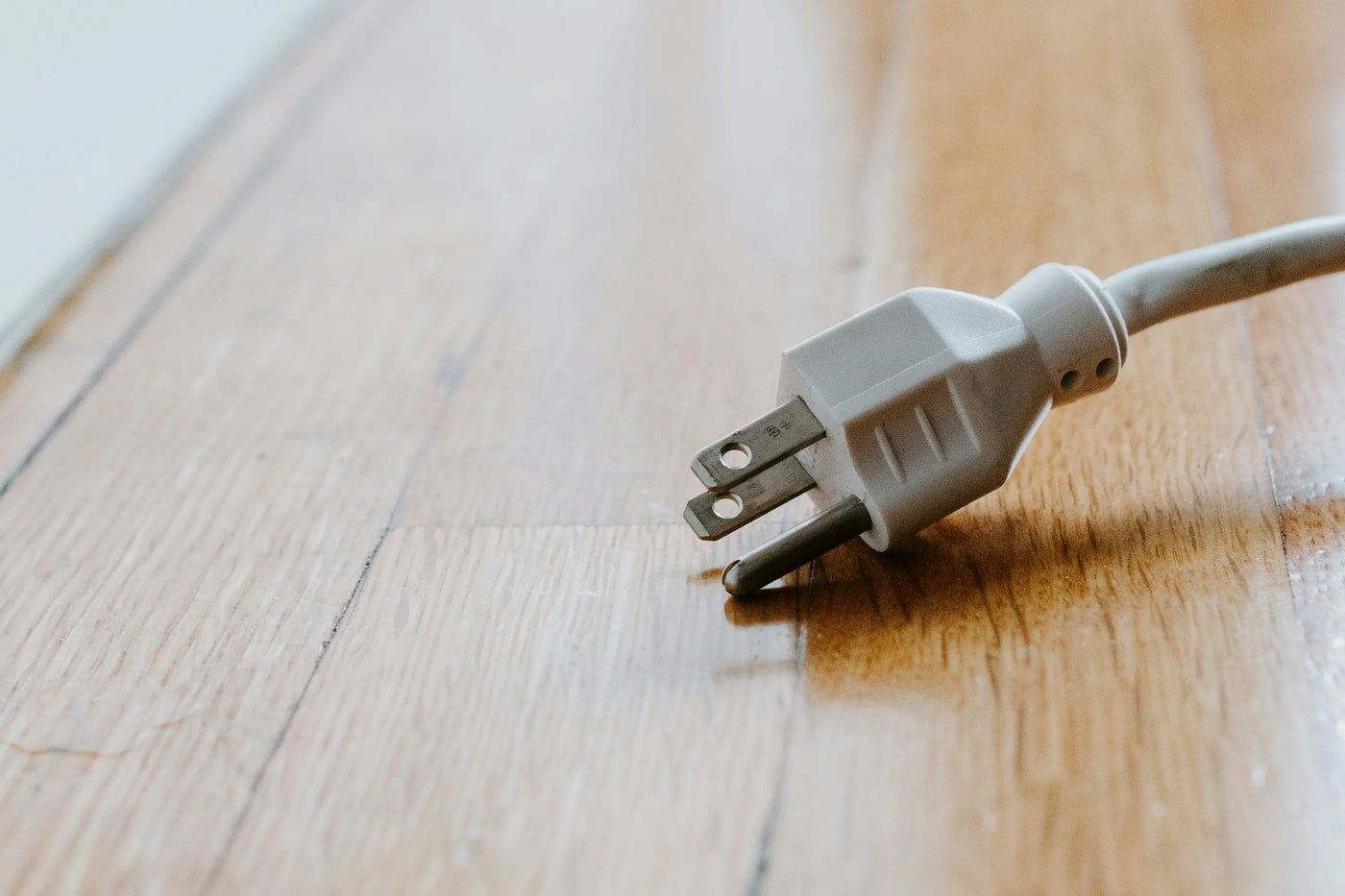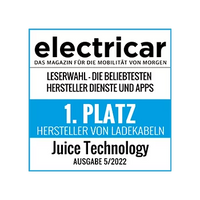sockets and plugs
Are you new to the world of electric cars? Then you'll be interested in this topic: What plugs are there, what goes through them and what should you look out for so that you don't burn down the whole place?
First an overview:
The variety of plugs on earth is gigantic. What we show you here are the most common and widely used plugs in many parts of the world (except North America) and especially in Europe. This will get you by as an e-driver. Details on all the plugs presented can be found below.
The charging speed of an electric car varies depending on the plug and current strength. However, it is easy to roughly calculate using the following formula: Number of phases * Ampere = km per hour. So if you connect an electric car to a 32-ampere socket with a three-phase cable, the battery will be charged with enough electricity per hour to cover almost 100 km.
Single-phase plugs
These are familiar from households, the blue ones from campsites.

three-phase plugs
These are mainly found in industry and gastronomy.

EV charging plug
These are used exclusively for charging electric vehicles.

Most common plugs
Single-phase plugs
These plugs have 3 poles: 1 phase (L), 1 neutral conductor ("N"), 1 protective conductor ("earth", PE).
Swiss plug T13

Internationally, this plug is called type J. It is actually very cleverly designed, as it is polarity-proof, offers a high level of hold in the socket and saves space. However, it is only available in Switzerland and Liechtenstein. Anyone travelling in this small country and wanting to plug in should still have one with them.
Danger:
The rated output is 10A, and as with all household plugs, the maximum load for continuous use is 80%, i.e. 8A. If the plug has slightly larger, square pins, then it is called T23 and can handle a maximum of 16A or 13A permanently.
Schuko plug (EU standard CEE 7/7)

Built and approved for 230V 16A. However, if used continuously for more than 1 or 2 hours, it should not be loaded with more than 13A to avoid overheating. The protective contact (hence the name Schu-ko), i.e. the earthing, is located at the top and bottom of the plug. The CEE 7/7 standard also provides for a hole above the two plug pins. This means that it also fits in sockets whose protective contact protrudes, which is common in France, for example.
Other EU plugs (I, UK etc.)

You can see that electricity has been around for a long time. Before people could drive to a standardization conference by horse and cart, progress had already blossomed in the countries and each country had its own plug system. Most are designed for 230V 13A, some for 16A. Here too, the following applies: If you are using the device continuously for more than 1 or 2 hours, you should only load it with 2 to 3A below the maximum value to avoid overheating.
CEE 230V 16A blue (called camping plug)

Built and approved for 230V 16A continuous load, it is in the broadest sense a more robust Schuko plug - with two important differences: It has reverse polarity protection between the neutral and phase conductors. An important safety factor, thanks to which it is ensured that the phase and not the neutral conductor is actually switched and therefore no more current is passed to the electrical device in question. In addition, with this plug, unlike the Schuko plug, you are protected from sparks if you pull it out under full load. It is mainly found on campsites and in France (our English friends find this list a pleonasm).
CEE 230V 32A blue

Built and approved for 230V 32A continuous load. Looks like the camping plug mentioned above, but is slightly larger in diameter. You often find it in England and France. It can only be used for single-phase charging, but at least with 32A. Of course, our set also includes an adapter from this plug to CEE32.
three-phase plugs
These plugs have 5 poles: 3 phases (marked L1, L2 and L3),
1 neutral conductor ("neutral conductor", designated N),
1 protective conductor ("earth", designated PE).
Don't be confused by the designation 400V. This voltage only exists between the three phases and can only be used by three-phase motors. An electric car, however, always draws the current between the neutral conductor and the phase, and there is 230V* in each case, but three times. With these connections, three times as much power comes out as with single-phase sockets with the same number of amps.
* If you want to know exactly, you can find more details in the chapter "Voltage and current strength"
Swiss standard for 400V 10A/16A

There is the T15 (10A) with round pins and the T25 (16A) with thicker square pins, both of which conduct three phases. This is actually a very clever solution, as a single-phase power can be drawn from the same socket using a T13 plug. This connection is extremely common in Switzerland, so an adapter like this is definitely worthwhile for electric vehicle drivers.
CEE16, 400V, 16A, red

Built and approved for 400V 16A three-phase continuous load. This is where charging electric cars becomes really interesting. Electric cars can charge at around 50 kilometers per hour. It is one of the best-selling adapters for our mobile chargers.
CEE32, 400V, 32A, red

Built and approved for 400V 32A three-phase continuous load. Looks the same as the CEE16, but is slightly larger in diameter. To charge an electric car, you need an additional fixed or mobile charging box (or a "downsizing adapter" to CEE16, of course included in our bag). The charging box "talks" to the vehicle via the Type 2 plug on the car and only sends power when the plug is securely locked to the car.
CEE63, 400V, 63A, red

Built and approved for 400V 63A three-phase continuous load. Looks the same as the CEE32, but is a little larger in diameter. Since most electric vehicles cannot take more than a maximum of 22kW alternating current (three-phase current), anything more than CEE32 makes no sense for our purposes. In addition, CEE63 (and the even larger CEE125) are very rare. If you can still find one (or order one from a city, for example), you can use our double plug "Juice Party 63" from CEE63 to two CEE32.

CEE16, CEE32, CEE63
The CEE plugs in size comparison.
electric vehicle plug
These plugs were specially developed for charging EVs (Electric Vehicles), i.e. electric cars.
Type 1 charging plug

The predecessor of the Type 2 plug, so to speak. Does essentially the same as the Type 2, but only 1-phase. It is still quite common because it is installed on the Nissan Leaf, the Opel Ampera/Chevy Volt and the Ford Focus, among others. There are transition cables from Type 2 to Type 1 so that the aforementioned car owners can also plug into public charging stations with a Type 2 socket.
charging plug Type 2 (Mennekes)

Has been the defined EU standard plug for charging electric cars since March 2013. Named after the company that invented it, Mennekes, this plug actually corresponds to a CEE32 plug plus 2 communication poles. This allows the car to "talk" to the charging box or charging station and confirm that the car is connected and ready to charge. The charging box then gives the signal to lock the plug and then starts supplying power (before this, the plug is not live). The charging power is usually 400V 32A - that of a CEE32 connection.
Many electric vehicles have a male connector on the charging socket. An increasing number of charging stations are equipped with a Mennekes female connector. Our set includes a cable with a Type 2 plug on each side.
Type 3 charging plug

Woe betide the industry if it smells blood and everyone creates their own standard. That's why a Type 3 was developed, but it has only become widespread in France, and there it is used excessively. This connection also does essentially the same thing as the Type 2 and is likely to be threatened with extinction. Anyone who wants to plug in in France can buy a rather expensive transition cable from Type 3 to Type 2 or Type 1 - or charge with a mobile charging box at normal sockets, which is probably the more sustainable investment.
charging plug CCS combo plug

In our opinion, another mistake made by the industry is this combination of a Type 2 plug (also available with a Type 1 plug) with an additional direct current connection underneath. CCS stands for Combined AC/DC Charging System. This allows you to use either alternating current (via the upper part) or already converted direct current (via the lower part). This means that the charging stations are extremely expensive, so they are less common, and because the plug is the size and sex appeal of an elephant killer, no one will want to hold it in their hand.
CHAdeMO charging plug

In Europe, there are already a number of direct current charging stations using the CHAdeMO system, which at least produces twice the power of standard public Type 2 charging stations. The plug is huge, incredibly expensive and makes any intergalactic ray gun look paltry - and therefore, in our opinion, should disappear sooner or later. There are two possible explanations for the somewhat silly-sounding name. (According to this theory, the Tesla Supercharger should probably be called COKEnBRGR.)
By the way, Tesla offers an adapter from CHAdeMO to the car.
Tesla Supercharger

Model S can also draw in direct current via the Type 2 plug* (and this is a brilliant Tesla solution). This is of course much faster because it does not need to be converted and can be fed directly into the battery. Tesla's own Supercharger stations offer direct current with 135kW. 20 minutes of charging therefore corresponds to 45kWh, so an 85kWh battery will be half full in this time.
* Strictly speaking, Tesla has installed a plug on its car that only looks like a Type 2, but is much stronger and can switch from Type 2 alternating current to direct current using the pilot signal. Hello CCS engineers: This is how innovation works!
Special plugs
You may also come across these plugs when traveling abroad.

CEE 4-pole, 400V, usually 32A, red

Called a container plug or farmer's three-phase plug. Has 3 phases and an earth conductor - but the neutral conductor is missing. Found quite often in Italy. Since electric cars always draw the current between the neutral conductor and the phase and not just between the phases like three-phase motors, charging is NOT possible at these sockets, even with adapters. The good news: In almost all house distribution boards, the neutral conductor is led from the transformer station. In this case, a local electrician can pull the missing wire and connect a standard 5-pin socket.
J15

Also called a farm plug. The J15 plug, which is only used in Switzerland, is actually the predecessor of the Swiss T25 and offers 400V three-phase 15A. It is rarely found in Switzerland, which is why we no longer offer adapters for it.
Italy, Type L (10A/16A)

We love Italy for its originality - here too: On the one hand, there is the 10A plug with 19 mm external spacing between the outer poles (included in our sets). On the other hand, there is the slightly larger 16A plug, with 26 mm external spacing. In new houses, you often find sockets where both plugs can be used. These may look strange (see illustration), but they serve their purpose. And for your next trip to Italy, we of course offer an adapter from the L 16A plug to CEE16 blue.
Plexo

Before the CEE16 and CEE32 made their breakthrough to Asterix, the Gauls had already covered their country with Plexo plugs. They are available in single and three-phase versions, from 20 to 32A. France had actually wanted to switch to the European standard CEE rail, but then the country's own plug manufacturer Legrand apparently found a few caverns full of Plexo. Because recently even new hotels are being equipped with the Plexo again.
CEE Plus

In addition to the Type 2 plug, Mennekes developed a system based on the globally standardized CEE plug, in which 4 low-current communication poles are integrated on the edge of each plug. Officially, there is the CEE blue (single-phase) with 16A and 32A and the CEE red (three-phase) with 16A and 32A. The idea is the same as with the Type 2 plug, which was developed later: in public areas, there is no power at the socket until the communication poles are short-circuited. The CEE-plus sockets are mainly found in Vorarlberg, Austria (vlotte.at) and occasionally in Ticino, Switzerland. The CEE-plus is considered dead and is gradually being replaced by the Type 2 standard, which is why we do not offer an adapter for it. If you still need one, you can contact rudolf.kloser@vkw.at with a greeting from us. He and his apprentices from Vorarlberger Kraftwerke will occasionally produce a few adapters from CEE16plus to CEE16 and sell them for around EUR 50 cost price.
labels
Cryptic connector labels
Because it can be so confusing, we have a few tips and explanations for you
CEE32 400V 32A - 6h

The idea of these standardized CEE plugs with color coding (blue = 230V (but not necessarily single-phase), red = 400V (usually three-phase)) is really good. The connections are quite robust and even officially rainproof - although you shouldn't push that too far. But what devil could have possessed these inventive engineers that only a trained eye can tell from the size whether it is a CEE16 or a CEE32? The designation is engraved in tiny letters on the plug itself, but by the time you can afford a nice electric car, you are already so old that your close vision is no longer sufficient for reading.
If you decipher the designation, you might be shocked to think that the plug can only be used for a few hours, because it says 6h, for example. But there is no reason to worry, because the ways of God and those of engineers are unfathomable. 6h only shows where the protective conductor on the plug is, like a clock face. CEE plugs are actually designed for continuous use.
IP44

The protection class designation IP, which stands for "International Protection Code", can be found not only on plugs (but on almost all electrical components, devices and housings). It looks complicated, but it is actually quite simple: the left digit stands for protection against foreign bodies and contact, the right digit for protection against water. The higher the digit, the better the protection. IP44, for example, means protection against foreign bodies with a diameter of at least 1.0 mm (e.g. grit or fiddling with a wire) and protection against splashing water from all sides (e.g. rain).
tangled cables
We have compiled the most important facts for you here.
The cable diameter

Cables can easily get warm to the touch when used continuously - but never hot, as this can cause the sheath to melt, resulting in a short circuit and a fire. You don't need a complicated measuring device to avoid this. Your hand is enough: if you can't hold the cable or plug in your hand for 20 seconds, it's too hot. If you come across cables whose sheath is already melting, please don't touch them.
In the event of the heat cases described above, disconnect the power supply immediately, preferably at the fuse or by pulling the plug.
First of all: the more "current" the cable needs to carry, the thicker the wire cross-section must be. In addition, a cable must never be rolled up (or even partially rolled up) because this creates a self-heating magnetic coil. Our sets therefore always contain fairly short units that can easily be rolled up (and unrolled) and extended in stages if necessary.
Many experts are of the opinion that flexible cables can always be one size smaller in diameter than installation wire with a stiff copper core. The recommended (working and proven) minimum thicknesses for flexible cables in mm2 per core are:
- 230V 16A: 1.5 mm2 (the specification for solid wire is 2.5 mm2)
- 400V 16A: 2.5 mm2 (the specification for solid wire is 4.0 mm2)
- 400V 32A: 4.0 mm2 (the specification for solid wire is 6.0 mm2)
But: It really can't get any thinner! We keep getting reports from owners of cheaply purchased cable reels where, in the best case, the built-in fuse blows out and, in the worst case, the sheath melts off. The cause is almost always a strand that is too thin, which is a real fire hazard!
extend the cable
Just because we use electricity every day doesn't mean it's safe. You can easily kill yourself with a 230V socket - and if you're unlucky, you can do it even if there's a residual current device that trips very quickly. With electric cars, we 'normal people' suddenly come into contact with currents that really get things going. That's why we need to be very careful when handling them, and especially when extending them. Above all, make sure that the plugs are always clean and dry. A short circuit at 400V 32A isn't really fun and you could easily kill an elephant with it (assuming you have one to hand). If you suddenly pull out a cable or extension when it's at full load (and when we charge, everything is always at full and continuous load), dangerous sparks can occur. That's why we also offer a plug protection case for extensions that protects against night owls and rain. The set also includes safety tape and a waterproof pen so that you can write in the local language that no over-eager idiot should unplug the power cord in the middle of the operation.
The right thing used correctly
Anyone using extension cables should pay particular attention to the minimum wire diameter. Since the advent of price-cutting hardware stores, cables with diameters that would be better used as doorbell wires for low-voltage doorbells have been circulating. Another very important thing for extension cable users: always unroll your cables completely. The heat generated by the current builds up in the middle of a cable roll. These temperatures can be so high that it can even melt the materials! As a rule of thumb: if part of the cable is still rolled up (one or two loops are enough!), the cable may only be loaded to a quarter of its intended load. Example: A 230V 13A cable with a 1.5 mm2 wire cross-section would actually be good for 3680 watts. When rolled up, it can withstand a maximum of 900 watts without overheating.
A question that we often get: By the way, Type 2 cables must NOT be extended - and they cannot be, because the plugs and couplings are designed to prevent this.
cable sheathing

Black or orange? Ultimately, it's a matter of taste. Some people consider the orange PUR plastic sheathing to be particularly robust, trip-proof (because it's conspicuous) and a bit lighter. Others prefer black PUR cables. And others say that the black rubber cables get less dirty (although you probably just see it less), are less noticeable (and therefore don't encourage you to paint) and, above all, are less stiff. We chose the latter because they are much more flexible and easier to put together without the cable jumping around like a stubborn snake and getting your pants dirty. They are definitely robust enough for daily hard use, unless you want to keep driving over them with a tank. But we don't recommend them.
Making Cables - Fire at Will
Can you install your ceiling light yourself at home? Great - but still keep your hands off EV cables. Some good reasons to do so:
- Cables, plugs and connectors for your electric car are almost always operated under constant full load. Even the smallest reduction in contact due to poorly connected plugs can lead to dangerous overheating.
- Swapping the phase and neutral conductors may be a minor issue in household applications (although not always), but it's no fun in an electric car.
- Hardly any household has the right wire end ferrules, crimping tools and the like that are necessary for professional installation.
- Type 2 plugs, for example, cannot be installed cleanly and in accordance with standards without expensive special tools.
Instead, rely on the adapters and cables offered by
e-driver.net, because ...
… they are planned, built and tested by relevant professionals
… they are individually tested
... the wire ends are precisely cut to length, sleeves and crimped individually - of course with the right tools. This guarantees an optimal, secure and almost loss-free connection.
… the cable diameters and the plug contacts match in terms of material choice, thickness and robustness
… and they are successfully used thousands of times every day by e-drivers!
You may find similar looking parts cheaper elsewhere. Don't be fooled, because we at e-driver.net are committed to offering you top quality at a first-class price - always as cheap as possible, but not cheaper, in fact designed for continuous use. At least that's some good news.













